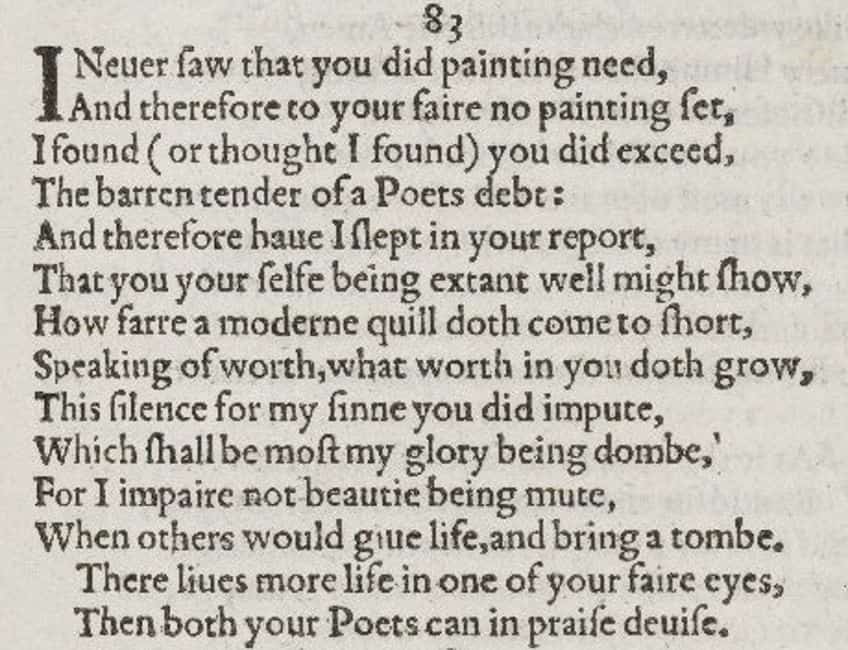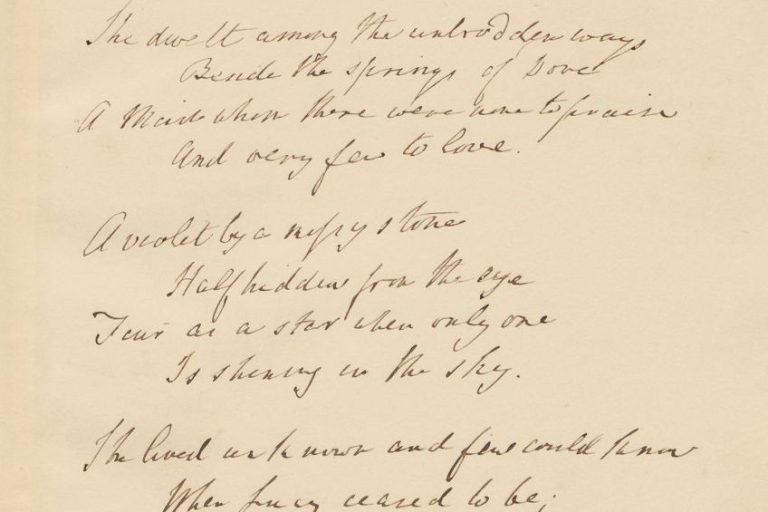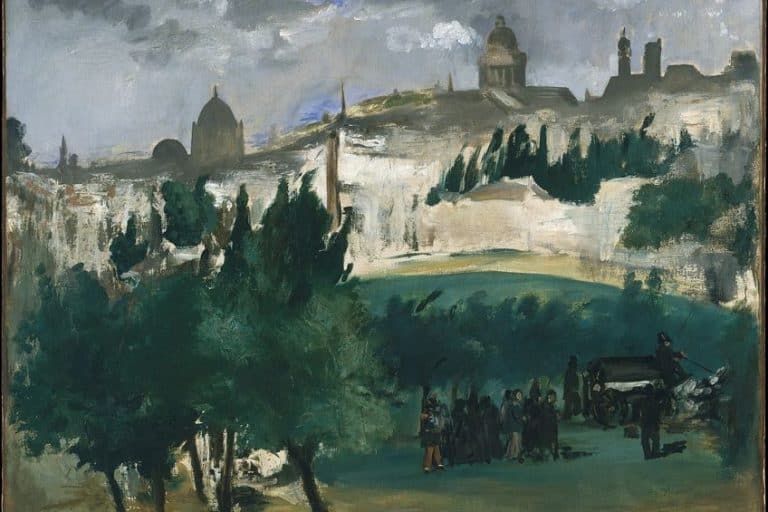How to Write a Sonnet – An Easy Poetry Writing Guide
How to write a sonnet; this is a great query. There are many ways to write a sonnet, and this article will discuss a few of the possible methods that could be adopted. We will examine different types of sonnets, different sonnet rhyme schemes, meter structures, and various other elements that form part of sonnets in general. If you want to learn how to write a sonnet, keep reading. You never know what you may learn!
How to Write a Sonnet
There are many different ways to write a sonnet, and none of those ways are necessarily correct or incorrect means of going about this task. Writing a sonnet is like every other kind of skill in that it requires a lot of practice. It may be a cliché, but it is true that practice makes perfect. Although, it is also worth remembering that when it comes to any kind of art, whether it’s written, illustrated, painted, filmed, and so on, is that perfection is something impossible to attain.

If you want to know how to write a sonnet, this article will give you some information about the sonnet format, sonnet rhyme schemes, sonnet structures, and some of the rules of a sonnet to get you started. However, it’s ultimately up to you to get started on writing your own sonnets. We will start with a look at some of the different types of sonnets because it is good to know and understand what sonnets are before attempting to write a sonnet. Thereafter, we will move towards some tips to get you started. So, let’s get ourselves started on looking at how to write a sonnet.
Types of Sonnets
There are a number of different types of sonnets, and in the contemporary era, a poet could easily write a sonnet that is entirely their own style. You do not need to necessarily follow any of these specific types of sonnets, but it can be helpful when you’re just getting started to imitate the greats.
It can often be best to first imitate your heroes when you get started in any of the arts, and writing sonnets is no different.
We are going to look at three of the most prominent types of sonnets, but always remember that you do not necessarily have to adopt any of these styles. However, it is worth noting that for a poem to have a sonnet poem structure, it does need to make use of fourteen lines. This is the most basic element of a sonnet. Everything else can be variable. But let’s first look at the non-variable sonnet structures.
Petrarchan Sonnet (Italian Sonnet)
The Petrarchan sonnet is a form of sonnet that is not necessarily all that common in English. There certainly are instances of it being used, but this sonnet type derives its name from Petrarch. This 14th-century poet was an Italian who revolutionized the sonnet in Italian, and while we will discuss him in more detail below, just know that he is the principal developer of this particular type of sonnet.

When it comes to this sonnet, it also makes use of a fourteen-line structure, but the sonnet rhyme scheme, in this particular case, is usually ABBAABBA CDECDE. This particular rhyme scheme does not flow as nicely in English as it does in Italian, but it can still be utilized. There are variations on this particular sonnet rhyme scheme, but this is the standard way in which it is arranged.
As can be seen, this particular sonnet format makes use of an octave (eight-line structure) followed by a sestet (six-line structure), and it is around these two main components that the poem is formulated. The octave generally involves some kind of a setup that is then resolved in the subsequent sestet.
This general structure will be discussed more below, but this is the most common way in which this particular sonnet style is arranged.
Shakespearean Sonnet (Elizabethan/English Sonnet)
The Shakespearean sonnet structure is, by far, the most famous type of sonnet in the English language for the simple reason that it is the sonnet structure that was most commonly used by William Shakespeare. While he was not actually the creator of this particular format, he did revolutionize it. His specific contribution to this form will be discussed in more detail in a later section of this article.

The Shakespearean sonnet structure makes use of the sonnet rhyme scheme: ABAB CDCD EFEF GG. This is a means of arranging the general sonnet structure around a series of four quatrains (four-line structures) and one rhyming couplet (two-line structure). While the octave and sestet system can still be used here as it is used in a Petrarchan sonnet for a setup and resolution, it is more common for a Shakespearean sonnet to reserve its conclusive segment for the rhyming couplet at the end of the poem.
This particular sonnet format traditionally makes use of iambic pentameter, and this was the meter that was used by William Shakespeare. However, this is not strictly necessary. In addition, unlike the Petrarchan sonnet, there is no real variability to the rhyme scheme when it comes to a Shakespearean sonnet structure.
The rhyme scheme is as it has been stated.
Spenserian Sonnet
The Spenserian sonnet structure is not as famous as either the Shakespearean or the Petrarchan, but it is one of the most common rigid forms after these two. It is named after Edmund Spenser, who was another 16th-century poet, although he was older than Shakespeare.

In this particular sonnet poem structure, the rhyme scheme is arranged as ABAB BCBC CDCD EE. Much like the Shakespearean sonnet structure, this type of sonnet makes use of three quatrains and a rhyming couplet, but the actual sequence of the rhyme is distinct from the Shakespearean. It instead makes use of an interlocking rhyme scheme that does distinguish it from the other two more famous sonnet writers.
However, even though these three sonnet styles have been discussed in some detail, it must be remembered that one does not actually need to make use of any of these forms. There is only one question that needs to be adhered to when it comes to a sonnet: How many lines are in a sonnet? If there are fourteen, then it can be classified as a sonnet.
However, there is no need for this form to necessarily entail the use of any of these specific and rigid sonnet formats.
Choosing a Sonnet Form
How does one go about choosing which sonnet form is best? This is a relatively tough question as it does depend on what you want to do. When it comes to a sonnet rhyme scheme, which is one of the main things that distinguishes each of the different types of sonnets, it can be easiest to either stick to a very rigid structure or to create your own.
This is not a simple choice, but it does heavily depend on the individual. Some people thrive within the inherent limitations of a certain form. Some people require structure while others prefer complete freedom, and depending on which type you happen to be, you may find that a rigid versus fluid structure is best for you.

However, for those starting out in the English language, it is often best to make use of the Shakespearean sonnet structure as it allows the writer a large potential number of lines, up to twelve, to establish the primary problem or idea behind the sonnet. The rhyming couplet at the end is an immensely satisfying conclusion to the problem that has been explored up until that particular point. So, for those who are just starting out, it may be easiest to go with the most common form available in the English language.
Crafting the Perfect Rhyme Scheme
A rhyme scheme is typically arranged along an end rhyme structure. This means that each line usually ends on something that rhymes in a certain sequence with other line endings. For instance, a simple line like, “Do not fear/I am here”, shows the way in which the end of the lines can be rhymed. However, one can also use beginning or internal rhymes. For instance, “Deer gallop along/fear in their eyes” or “He has spent my money/I shall vent my emotions”, respectively.
However, it is worth noting that many cannot really hear rhyme unless it’s at the end of a line.
In addition, you can mix up your rhyme. For instance, you could have both beginning and end rhymes. However, when making use of any of the more traditional structures also means making use of the rhyme schemes inherent in them. In more traditional poems, rhyme schemes generally refer to end rhymes only. So, if you want to try something new, then you need to experiment. Experimentation is the only way that you will figure out the way that you personally want to rhyme.
Meter and Rhythm in Sonnets
Meter is the way in which a poem is arranged according to a certain beat. The most common form of meter, which is found in most Shakespearean sonnet structures, is iambic pentameter. This is the way in which a poem will make use of a stressed and unstressed syllable structure. This means that a poem has a certain Da-dum, Da-dum, Da-dum flow to it.

This is an aspect of many poems that can be difficult to grasp or hear. However, there are various types of meter that can be used for various effects. Iambic pentameter is often considered to be relatively basic and standard, but a style that, for instance, instead produced a Da-Da-dum-Da flow could serve as a way to vary the feeling of a poem.
The Volta: Turning Point in Sonnets
The volta is a very common characteristic in sonnets. The volta is a shifting point in the text, and it marks a change in the general tone. The volta’s location can vary, and in the Petrarchan sonnet it is typically after the octave, and in a Shakespearean sonnet, it could be after the octave or after the third quatrain. However, what you need to know about the volta is that it allows for a shift in the feeling and presentation of a poem.
The reason a volta is typically seen as necessary is because without one there would not be a shift from the problem to the resolution. A sonnet, in the typical sense, would start by exploring an idea such as love, but it would then shift in the final section, after the volta, to be about how love can die.
This is not the only way in which a sonnet can be structured but is simply an example.
The reason it becomes important to understand when to make use of a volta is because it can be extremely effective. For instance, in Shakespeare’s Sonnet 130, also known as My mistress’ eyes are nothing like the sun, the tone shifts after the third quatrain. During the three quatrains, the poem can be seen as quite mean-spirited as it describes a woman with very unflattering terms, but the final two lines shift away from that and instead affirm a deep and unflinching love. This late volta allows us to realize, at the last minute, that everything before the volta, despite appearing to be cruel, was part of the beauty.
This is something that you too can master through practice. Now, that example made use of a Shakespearean sonnet structure and so it ended on a couplet, but many sonnets are arranged around an octave and sestet, with the volta taking place after the octave. So, let’s examine them a little before moving on.

Writing the Octave (First Eight Lines)
Many sonnets tend to be structured around an octave introductory segment, and these first eight lines are meant to be the central conflict around which you are exploring an idea. It is in these first eight lines where you will establish the theme, the idea you want to discuss, and the feeling that you are experiencing. This part of the poem can allow you to say whatever you want. Remember the cruelty discussed in Sonnet 130 above? Well, a similar strategy could be adopted.
You are expressing yourself here. You are saying what you feel needs to be said, and then the volta happens.
Developing the Sestet (Last Six Lines)
The sestet follows on from that establishment of the theme or conflict. The volta represents the shift, and the final six lines allow you to resolve the conflict. For instance, you may have immensely negative feelings that you have expressed in your octave, and that’s fine. For instance, imagine a poem in which the first eight lines are about self-esteem and self-loathing, but after the volta, the final sestet allows you to confront and refute those feelings. It allows you to deny and defy the negative. To reassert a positive conclusion. Furthermore, it’s a great way to establish a memorable closing.

Using Imagery and Figurative Language
Imagery is one of those terms that can be somewhat confusing at first. We have all heard the expression that “a picture is worth a thousand words”, well when writing, you need to tell those thousand words. You need to paint a picture with words and describe a figurative environment.
Near the end of this article, we will examine some of the imagery used in a particularly famous sonnet.
If you make use of figurative language, such as through the use of similes and metaphors, then you will be better be able to convey the thoughts that you wish to convey. A picture may be worth a thousand words, but your words could deeply explore the feelings behind the picture in your mind’s eye. Furthermore, a picture in your mind is one unshaped and undisturbed by the real world around us.
Sonnet Themes and Topics
There are many different themes and topics that are often explored in sonnets. When it comes to how to write a sonnet, you do not necessarily have to make use of any specific themes, but here are some of the most common ones:
- Love and romance. This is one of the most famous topics that is explored within sonnets. Feelings of love, whether they are true or not, have been adopted in poetry since the beginning. Both Shakespeare and Petrarch were particularly known for exploring concepts like this.
- Nature and beauty. This is a topic that was of particular interest to the Romantics. The natural world has often been juxtaposed against the “civilized” one as a means of criticizing the way that humans have oriented their lives around cities while abandoning the beauty and majesty of the natural world.
- Time and mortality. This is another of the topics for which William Shakespeare was particularly known for pursuing. The way in which immortality does not actually exist, and how we are all ultimately going to age, decay, and eventually die is a reality of our world. This is a particularly potent topic that has often been explored in sonnets.
- Social and political commentary. This theme has often been explored by writers of sonnets and beyond. The world in which we live is one that is often difficult and full of conflict. The sonnet can be a perfect avenue through which our feelings about the human world can be explored.

These are not the only themes and topics that can be explored when writing sonnets, but they are some of the most common ones. So, what will you write about? Will you have your own take on any of these, or do you have something entirely different in mind?
Adding Emotional Depth
It is important to do your best to understand emotion while writing a poem. Poems are not like novels. Novels explore a complex array of themes through characters and continuous storytelling. Poems, and especially sonnets, are often best at exploring a single concept at a time. And you need to do your best to inject empathy into what you create, to try to understand not only yourself but others too. Very little in this world is truly universal, but what you think about and write about may just resonate with others.
So, tell your story from your heart and hold nothing back.
Editing and Revising Your Sonnet
Once your poem is complete, or at least once the first draft is complete, you should not consider yourself to be done. There is still work to do! You need to revise it. Read it to yourself, but it is best to do so out loud. Hear what it sounds like. Make adjustments if any adjustments need to be made. You can also read it to someone or ask someone else to read it. Any feedback that you can receive will be beneficial.

If you are new to writing in general, hearing feedback can be very difficult. However, you should not seek out praise alone. You want constructive feedback. You want constructive criticism. It can be very hard to hear criticism in the beginning, but it’s important to remember that not everyone will like what you have created, and nothing on this earth that is made by people is perfect. No sonnet you write will be perfect. That should never stop you though.
You need to edit your work, seek feedback, and then start over. You cannot write a single sonnet and then be done forever. However, there is still a lot that you can do to improve on your abilities. There are likely other thoughts in your head, other ideas that you wish to explore.
So, try them out! You have nothing at all to lose in this world. And with each poem you write, the better you’ll get.
Prominent Sonnet Writers
We are going to examine only two of the most prominent sonnet writers as they are two of the most important figures in the history of the sonnet. When it comes to writing a sonnet, it can also often be beneficial to understand how the greats wrote their poems, and so we will look at two of the masters before looking at how one might interpret them.

Petrarch: Pioneer of the Italian Sonnet
| Sonnet Style | Italian |
| Years | 1304 – 1374 |
| Place of Birth | Arezzo, Italy |
| Known For | Il Canzoniere (1330 – 1374) |
Petrarch, whose real name was Francesco Petrarca, was an Italian scholar and poet. While he may have been an immensely important figure in the development of the Petrarchan sonnet, he is also considered to be one of the most important philosophers in the early humanist tradition.
His sonnets, predominantly those collected in his Il Canzoniere concern his unreciprocated love for a woman.
His poetry has become some of the most important in the field of love poetry, and a major influence on the use of poetry as a means through which to express romance. There tends to be a view in the contemporary era that poetry is something someone can use for love purposes even though much of poetry has absolutely nothing at all to do with love, but the influence of Petrarch has contributed to that belief. However, let’s now turn our attention to some of the more contemporary views of sonnets.

Shakespeare: The Master of Sonnets
| Sonnet Style | Elizabethan/English |
| Years | 1564 – 1616 |
| Place of Birth | Stratford-upon-Avon, England |
| Known For | The Sonnets (1609) |
William Shakespeare was not the creator of the Shakespearean sonnet structure, but thanks to his 1609 collection of sonnets, the format has essentially been named after him. Technically, the type of sonnet that is labeled the “Shakespearean” can also be called the English or Elizabethan sonnet.
However, hardly anyone knows that particular sonnet structure by that name.
Shakespeare was not only famous for his sonnets but also for his plays, such as Romeo and Juliet and Hamlet. However, he has become known as the master of sonnets because of his extensive use of them to convey a lengthy story of two notable sequences concerning his character of the Fair Youth and the Dark Lady.
He used his sonnets to explore themes around love, immortality, mortality, time, and impermanence. His poetry has become an inspiration to sonnets for centuries, and if you wish to learn how to write a sonnet, it may be beneficial to give a few of them a read. You learn by watching the master at work.

Modern Sonnets and Contemporary Interpretations
Sonnets are often considered to be somewhat old-fashioned. When it comes to the contemporary era, many poems tend to shun the rules of all poetry and not only the rules of a sonnet. Free verse has, in many ways, become the ruling king in contemporary poetry as many modern poems do not adopt any rigid structures.
However, while rigid structures may have been swept to the wayside when it comes to much contemporary poetry when sonnets are still adopted, they are often adopted with modern sensibilities. This can often mean that contemporary sonnets may entirely shun the rules of a sonnet aside from the fourteen-line rule.
That is the one rule that determines whether or not something is or is not a sonnet.
However, sonnets such as the one titled Sonnet by Billy Collins is a good example of the way in which contemporary writers may toss convention aside. This poem does not actually have a proper sonnet rhyme scheme, the meter is variable, and it does not conform to the volta structure so often seen in sonnets. It is also not about many of the traditional things that sonnets tend to be about. For instance, it isn’t about love or time but is instead about sonnets. It is a critique and commentary on the very nature of the sonnet as a type of poem.
Sonnets can still be used to this day to explore a variety of ideas, and you should never feel constrained by the supposed rules of a sonnet. There may be rules to certain forms, but you do not need to conform to those rules. Do what you like! Who cares!? If you want to write a sonnet and ignore all the supposed rules, then do so. If you want to make up your own sonnet poem structure with its own special rhyme scheme and meter, then do so. If you want it to be about trees or factories or bodily functions, then do so. When it comes to how to write a sonnet, one of the first things you need to do is decide on what you’re going to write about, and you can write about whatever you want.

A Famous Sonnet Example: Ozymandias (1818) by Percy Bysshe Shelley
| Date Published | 1818 |
| Type | Non-standard sonnet |
| Rhyme Scheme | ABABACDCEDEFEF |
| Meter | Loose iambic pentameter |
| Topic | Impermanence of power |
We are going to look at one example of a sonnet today: Ozymandias by Percy Bysshe Shelley. This is one of the most famous sonnets ever written, and it does not follow a particular sonnet structure. So, let’s give it a very brief look so that we can see some of what it does and why it does that so well. Always remember that you can learn how to write by reading and analyzing. See how the greats do things, and perhaps some of that will rub off on you.
The poem, in general, is about a strong theme. It is about the figure of Ozymandias, also known as Ramesses II. This Egyptian pharaoh was considered to be one of the greatest to have ever lived, and his empire was vast, and his military conquests were numerous. He was a figure who was larger than life, and the poem about him focuses on a statue of him. That statue was once as great as he was, but it has since fallen into decay as it has been thousands of years since it was constructed. The poem is about this impermanence, the way in which the supposed might and power of these grand rulers will wash away with time like everything else.
Already, the poem has a good launching point, but how is it conveyed? It starts with a first-person character, the person writing the poem, but they are not the one telling the story.
The poem, in the second line, transfers to the use of dialogue. The remainder of the text is recorded speech. They are the words of an unnamed traveler. This traveler tells the tale of this once-great statue. They describe the statue. They describe the greatness, the monumental scale of it, and the way in which the face upon the statue was clearly designed by someone who knew the face of the ruler. The poem then describes that face. It has a wrinkled lip as it frowns outwards onto the world. It is a face used to the power. It is a face that expects to be followed and adhered to. It is a face of a man who sees himself as a god.
And the next words describe what is written upon the pedestal of this once-great statue. The words proclaim that he is the “King of Kings” and that all around him is great and powerful. He even warns the “Mighty” to be afraid of him. However, the remainder of the poem shifts from that inscription and instead gazes at the world around the statue. The supposed “Works” that Ozymandias created are long gone. Even his statue is not fully intact. His supposed greatness has been washed away by the sands of time. He is nothing any longer. Hardly anyone knows him. He is not a god, a ruler, a great being. He is a long-dead person and everything he made is gone.

This is one of the most famous non-Shakespearean poems and for good reason. It is a powerful poem and one that has a message to present to us. It reminds us, those who are not great rulers who created grand things, that our accomplishments will also fade away until no one remembers them. The difference is that we probably won’t get a poem dedicated to how we have lost everything. And through reading and analyzing poems such as these, we can learn how to write a sonnet. We can learn how to structure ourselves. A poem does not need to follow the rules of a sonnet, this poem does not, and so why should you?
We often feel that we have little to learn from ancient texts and sources, but there is actually much to learn. You also don’t need to read Shakespeare to experience good and powerful works such as this. You only need to do a quick internet search and find some sonnets to read. The more you read, the more you’ll learn.
And, like Ozymandias, we have come to the desolate conclusion. This article will one day eventually crumble away when the servers vanish, but for now, it shall remain for all who wish to learn a little about how to write a sonnet. We have examined various aspects of sonnets, from sonnet structures to sonnet rhyme schemes and beyond. However, all that’s left for you to do is to try it for yourself. So, give it a go! You never know what you’ll be able to create.
Frequently Asked Questions
What Is a Sonnet?
A sonnet is a type of poem that makes use of a fourteen-line structure. There are a number of different types of sonnets and they each include their own rules, rhyme schemes, and general structures.
How Many Lines Are in a Sonnet?
This is the only component of a sonnet that is truly non-negotiable. A sonnet needs to have fourteen lines. Those fourteen lines can be arranged in a variety of rhyme schemes and other structures, but so long as there are fourteen lines, then it is a sonnet.
How Many Types of Sonnets Are There?
There are many different types of sonnets. In the contemporary era, there are no necessary rules of a sonnet. Any sonnet could have its own layout, but some of the most common of the more rigid types of poems include the Petrarchan, Spenserian, Miltonic, and Shakespearean sonnet structures.
Who Is the Most Famous Sonnet Writer?
The most famous sonnet writer is William Shakespeare. Or at least this is the case in the English language. This figure became so notable for his use of a specific style of sonnet that it became known as the Shakespearean sonnet. However, Shakespeare is also well known for his plays.
What Is the Best Sonnet Form for Beginners?
If you are writing in English, it may be best to start with a Shakespearean sonnet. This sonnet structure is beneficial because it allows the writer to spend most of the sonnet describing an issue of some kind before allowing the rhyming couplet at the end to serve as some sense of resolution. That rhyming end is also immensely satisfying.
How Do I Find Inspiration for My Sonnet?
Inspiration for sonnets can come from anywhere. However, as sonnets are commonly about emotions and personal thoughts, these can be good places to mine for inspiration. What’s on your mind at the moment? What do you think about? How are you feeling? All of these can serve as means of determining what your sonnet could be about.
Can I Break the Traditional Rules of Sonnet Writing?
You can break practically every rule of writing a sonnet. You can use one of the rigid types of sonnets or create your own. Use an established meter or don’t. Use an established rhyme scheme, your own, or none at all. The only real rule that is always necessary to follow is to use fourteen lines. If you use a different number of lines, then it will likely become free verse, especially if you’re making up your own rules along the way.
Justin van Huyssteen is a freelance writer, novelist, and academic originally from Cape Town, South Africa. At present, he has a bachelor’s degree in English and literary theory and an honor’s degree in literary theory. He is currently working towards his master’s degree in literary theory with a focus on animal studies, critical theory, and semiotics within literature. As a novelist and freelancer, he often writes under the pen name L.C. Lupus.
Justin’s preferred literary movements include modern and postmodern literature with literary fiction and genre fiction like sci-fi, post-apocalyptic, and horror being of particular interest. His academia extends to his interest in prose and narratology. He enjoys analyzing a variety of mediums through a literary lens, such as graphic novels, film, and video games.
Justin is working for artincontext.org as an author and content writer since 2022. He is responsible for all blog posts about architecture, literature and poetry.
Learn more about Justin van Huyssteen and the Art in Context Team.
Cite this Article
Justin, van Huyssteen, “How to Write a Sonnet – An Easy Poetry Writing Guide.” Art in Context. September 7, 2023. URL: https://artincontext.org/how-to-write-a-sonnet/
van Huyssteen, J. (2023, 7 September). How to Write a Sonnet – An Easy Poetry Writing Guide. Art in Context. https://artincontext.org/how-to-write-a-sonnet/
van Huyssteen, Justin. “How to Write a Sonnet – An Easy Poetry Writing Guide.” Art in Context, September 7, 2023. https://artincontext.org/how-to-write-a-sonnet/.









